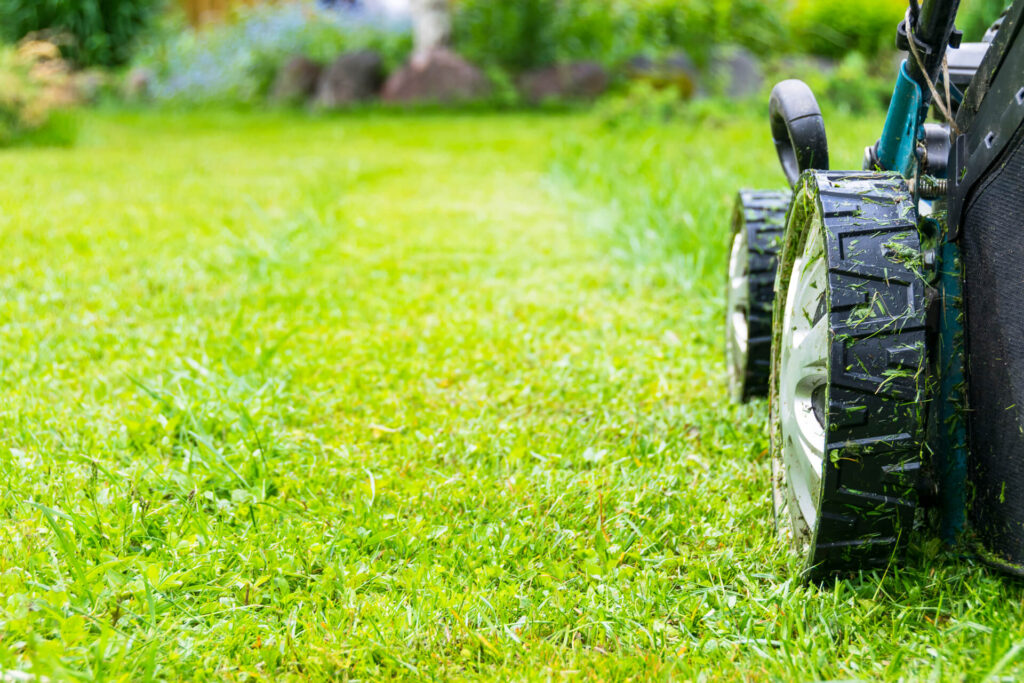A beautifully kept garden makes a fabulous first impression and can give your property’s value a real boost, too.
You won’t believe how little time and money you actually need for a picture-perfect lawn. It all comes down to a few key practices, and that’s exactly why we’re here.
So, without further ado, let’s explore how to achieve and maintain that perfect slice of paradise you’ve always dreamt of.
Selecting the Right Tools
Before diving straight into the nitty-gritty of lawn maintenance, let’s discuss how to select the right equipment. After all, the tools you choose directly affect the final outcome.
Start by selecting the type of mower that best suits your needs. Battery-powered models are more convenient and easier to use, while their old-school, manual counterparts offer better control without draining your wallet.
You’ll also need a durable rake for seasonal cleanups and routine upkeep.
For seasonal or sporadic tasks, like aeration, you can just rent the necessary equipment from your local DIY shop. This is a more affordable option for those on a tight budget.
It goes without saying that safety comes first. So, put on some sturdy gloves and goggles to protect yourself from the sharp bits and flying debris.
Earmuffs are also a must when using loud machinery, and so are cushioned knee pads. They’ll keep you comfortable while plucking out those pesky weeds.
If you’re just getting started, you don’t need to splurge on everything at once. Instead, build your toolkit gradually by adding new items as your needs and expertise grow.
Understanding Grass Types
Different types of grass thrive in specific environments. The most suitable kind for your home depends on your local climate, soil quality, and the amount of time you’re willing to invest in yard maintenance.
For example, ryegrass and Kentucky bluegrass perform better in cooler regions. In contrast, Zoysia and Bermuda flourish in warmer environments, thanks to their outstanding drought and heat resistance.
If you’re not quite sure which strain to select, consult your local nursery. The knowledgeable staff there can recommend the best options for your climate.
Leveraging Effective Mowing Strategies
If you want your lawn to be the talk of the neighbourhood, you have to hone your mowing technique.
Start by sharpening your blades. This ensures clean cuts and prevents those unsightly brown patches that can make your turf seem neglected.
Expert gardeners recommend keeping the grass between 6 and 7 centimetres long. Cutting it too short can weaken it, while letting it grow too long can attract unwanted pests. Finding that sweet spot takes practice, but the results will be worth the effort.
To keep your turf strong, mow it in a different direction each time and wait until it dries before cutting it to avoid tearing or clumping.
To boost its health, use the clippings as fertilisers. They’ll enrich the earth with essential nutrients as they break down.
Efficient Watering Techniques
With a few mindful adjustments, your watering habits can make a real difference to both your garden and your wallet.
Dawn is the best time to irrigate your lawn before the sun has a chance to steal the moisture away. However, you have to be careful with the amount you supply.
Drenching the grass, especially in the winter, can invite pesky fungi. Ideally, you’ll want to water deeply, yet sparingly, for faster root growth and a more resilient turf.
Test the soil with a stick or screwdriver to see if your grass needs watering. If it slips easily into the ground, it’s damp enough. If it hits a dry patch or you sense some resistance, that’s a sign that your greenery is dehydrated.
While you’re at it, consider popping in a rain gauge to keep tabs on natural showers. That way, you can adjust your watering schedule with ease.
Lastly, if you’re willing to splurge, a smart sprinkler system is well worth the investment. It delivers moisture directly to the roots, reducing waste and streamlining your landscaping routine in one fell swoop.
In the long run, these simple changes will help reduce your utility bill.
Fertilising for Healthy Growth
Think of fertiliser as your lawn’s hearty meal. Just as you thrive on a balanced diet, your grass needs the right nutrients to stay lush, green, and full of life.
Most stores offer two main types: organic and synthetic fertilisers. Natural options work more slowly but tend to be better in the long run, as they gradually improve the soil’s health.
On the other hand, artificial varieties show quick results, but you must be careful with them to avoid harming your grass.
When applying these supplements to your turf, you have to choose your timing wisely. Cool-season strains need feeding in early spring and fall when they’re actively growing.
In contrast, warm-season grasses thrive when fertilised in late spring and summer during their peak growing season.
Most importantly, you need to spread the nutrient mix evenly to cover the entire area without oversaturating certain spots. Otherwise, you might burn the grass unintentionally.
Make sure you test the soil before buying any product. A simple DIY testing kit from your local garden centre will tell you exactly what your lawn needs. This, in turn, will help you save a small fortune and avoid costly mistakes.
Controlling Pests and Weeds
Your yard is essentially a mini, natural sanctuary. If pesky insects are allowed to settle in, they’ll disrupt the overall feel of the space.
Notorious troublemakers, like chafer grubs and leatherjackets, leave dead patches in their wake, making your once-pristine lawn seem neglected.
Luckily, the solution is easier than you think. You see, healthy, well-tended grass naturally fends off many invaders. So long as you give your turf the love it deserves, you won’t have to worry about those unwanted visitors too much.
That said, it’s still wise to use some form of pest control. Natural products, like neem oil, offer a safer way to manage pests without harming beneficial insects or polluting the soil.
These gentler solutions target opportunistic bugs while sparing the helpful critters your garden’s ecosystem depends on.
As for invasive plants, sometimes the simplest approach works best—simply pull them out by hand as soon as they appear.
Natural mulch can be especially useful here. Not only does it stop new weeds from germinating, but it also helps the soil retain moisture better during hot spells.
Seasonal Upkeep Routines
As any seasoned gardener will tell you, you have to adjust your upkeep routine as the seasons change. Here’s a simple breakdown of the key tasks you have to perform to keep your lawn thriving all year long.
Spring
As winter comes to an end, your lawn will need a little extra care to bounce back. Start by aerating the soil to help air and nutrients reach the roots where they’re needed most.
Then, overseed any thin or bald patches to encourage thicker growth and achieve that coveted, well-groomed look.
Summer
Summer’s toasty months bring their own set of challenges. As the mercury rises, adjusting your watering routine becomes absolutely essential.
An even layer of mulch helps lock in moisture and keep it from evaporating too quickly. Additionally, you’ll need to monitor the area carefully for signs of stress or pest activity. These nuisances can easily spiral out of control under intense heat.
Autumn
This is the perfect time to prepare your turf for the coming winter. So, rake up the fallen leaves and give your lawn one last feeding with a suitable fertiliser to help it survive the cold months ahead.
The work you do now will ensure that your grass can withstand harsh weather conditions and remain healthy right through till spring.
Winter
The best way to make the most of these quieter months is by maintaining your tools and storage. This will help you avoid costly replacements later on.
Use this time to outline next year’s goals, and note down what worked well this past growing cycle and what could use some improvement.
Based on your observations, modify your approach to match your local climate and the specific needs of your yard. This forethought will pay off once the frost lets up.
Conclusion
Getting to know your lawn’s quirks and tailoring your landscaping routine accordingly yields dazzling results.
So, take your time and savour the journey. Embrace your mistakes, learn from them, and adjust as you go.
Before long, your hard work will bloom into a vibrant, welcoming haven that sparks joy every time you step outside.








